#Web Accessibility & WCAG Solution
Explore tagged Tumblr posts
Text
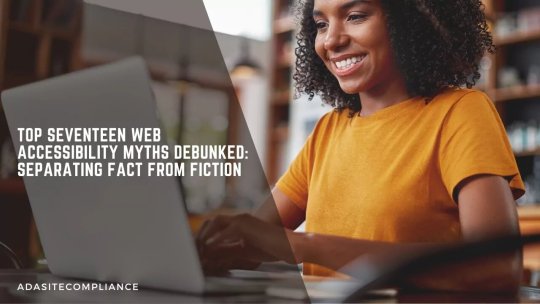
Accessibility Benefits For Businesses
ADA Site Compliance shows the benefits of accessibility for businesses!
#Web Accessibility Myths#Digital Accessibility#ADA Compliance#WCAG Compliance#Inclusive Web Design#Accessibility Testing Tools#Assistive Technologies#Accessible Website Design#Web Compliance#Accessibility Guidelines#Accessibility Misconceptions#Keyboard Navigation#Alt Text for Images#Accessibility Overlays#Color Contrast#website accessibility solutions#ADA site compliance#ADASiteCompliance#adasitecompliance.com
1 note
·
View note
Text
#Kiosk Accessibility#Designing Accessible#Implement Accessibility#WCAG#Disabilities#Screen Readers#Section 508#Color Contrast#Accessibility Audit#web accessibility Audit#Designer Accessibility#Accessibility Testing#Accessibility Solutions#Accessibility Tools#Accessibility Technology#Facial Recognition#Biometric Verification#Inclusive Design#Universal Design#User Testing#Web accessibility#AEL Data
0 notes
Text
The Ultimate Guide to Web Development
In today’s digital age, having a strong online presence is crucial for individuals and businesses alike. Whether you’re a seasoned developer or a newcomer to the world of coding, mastering the art of web development opens up a world of opportunities. In this comprehensive guide, we’ll delve into the intricate world of web development, exploring the fundamental concepts, tools, and techniques needed to thrive in this dynamic field. Join us on this journey as we unlock the secrets to creating stunning websites and robust web applications.
Understanding the Foundations
At the core of every successful website lies a solid foundation built upon key principles and technologies. The Ultimate Guide to Web Development begins with an exploration of HTML, CSS, and JavaScript — the building blocks of the web. HTML provides the structure, CSS adds style and aesthetics, while JavaScript injects interactivity and functionality. Together, these three languages form the backbone of web development, empowering developers to craft captivating user experiences.
Collaborating with a Software Development Company in USA
For businesses looking to build robust web applications or enhance their online presence, collaborating with a Software Development Company in USA can be invaluable. These companies offer expertise in a wide range of technologies and services, from custom software development to web design and digital marketing. By partnering with a reputable company, businesses can access the skills and resources needed to bring their vision to life and stay ahead of the competition in today’s digital landscape.
Exploring the Frontend
Once you’ve grasped the basics, it’s time to delve deeper into the frontend realm. From responsive design to user interface (UI) development, there’s no shortage of skills to master. CSS frameworks like Bootstrap and Tailwind CSS streamline the design process, allowing developers to create visually stunning layouts with ease. Meanwhile, JavaScript libraries such as React, Angular, and Vue.js empower developers to build dynamic and interactive frontend experiences.
Embracing Backend Technologies
While the frontend handles the visual aspect of a website, the backend powers its functionality behind the scenes. In this section of The Ultimate Guide to Web Development, we explore the world of server-side programming and database management. Popular backend languages like Python, Node.js, and Ruby on Rails enable developers to create robust server-side applications, while databases such as MySQL, MongoDB, and PostgreSQL store and retrieve data efficiently.
Mastering Full-Stack Development
With a solid understanding of both frontend and backend technologies, aspiring developers can embark on the journey of full-stack development as a Software Development company in USA. Combining the best of both worlds, full-stack developers possess the skills to build end-to-end web solutions from scratch. Whether it’s creating RESTful APIs, integrating third-party services, or optimizing performance, mastering full-stack development opens doors to endless possibilities in the digital landscape.
Optimizing for Performance and Accessibility
In today’s fast-paced world, users expect websites to load quickly and perform seamlessly across all devices. As such, optimizing performance and ensuring accessibility are paramount considerations for web developers. From minimizing file sizes and leveraging caching techniques to adhering to web accessibility standards such as WCAG (Web Content Accessibility Guidelines), every aspect of development plays a crucial role in delivering an exceptional user experience.
Staying Ahead with Emerging Technologies
The field of web development is constantly evolving, with new technologies and trends emerging at a rapid pace. In this ever-changing landscape, staying ahead of the curve is essential for success. Whether it’s adopting progressive web app (PWA) technologies, harnessing the power of machine learning and artificial intelligence, or embracing the latest frontend frameworks, keeping abreast of emerging technologies is key to maintaining a competitive edge.
Collaborating with a Software Development Company in USA
For businesses looking to elevate their online presence, partnering with a reputable software development company in USA can be a game-changer. With a wealth of experience and expertise, these companies offer tailored solutions to meet the unique needs of their clients. Whether it’s custom web development, e-commerce solutions, or enterprise-grade applications, collaborating with a trusted partner ensures seamless execution and unparalleled results.
Conclusion: Unlocking the Potential of Web Development
As we conclude our journey through The Ultimate Guide to Web Development, it’s clear that mastering the art of web development is more than just writing code — it’s about creating experiences that captivate and inspire. Whether you’re a novice coder or a seasoned veteran, the world of web development offers endless opportunities for growth and innovation. By understanding the fundamental principles, embracing emerging technologies, and collaborating with industry experts, you can unlock the full potential of web development and shape the digital landscape for years to come.
2 notes
·
View notes
Text
10 Web Developer Secrets You Need to Know for Success in 2024
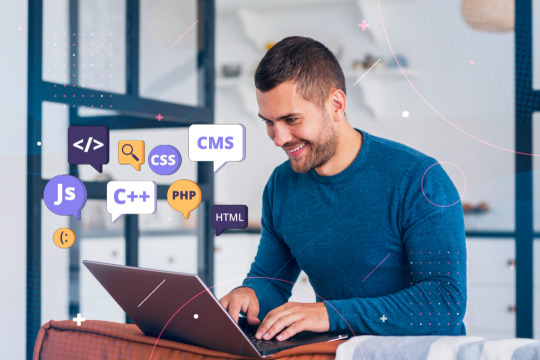
In the fast-paced world of web development, staying ahead of the curve is essential for success. As we venture into 2024, it's crucial to uncover the latest secrets and strategies that can propel your web development endeavors to new heights. Let's delve into ten invaluable insights that every web developer should know for a prosperous year ahead.
Embrace Progressive Web Apps (PWAs)
In 2024, the prominence of Progressive Web Apps (PWAs) continues to soar. These innovative web applications offer users an immersive, app-like experience directly from their browsers. By embracing PWAs, developers can enhance user engagement, improve performance, and seamlessly integrate features like push notifications and offline functionality.
Prioritize Mobile-First Design
With mobile devices dominating internet usage, prioritizing mobile-first design is non-negotiable. Crafting websites with mobile users in mind ensures optimal responsiveness and usability across various devices and screen sizes. Embrace responsive design principles to deliver a seamless browsing experience that caters to the needs of your audience.
Harness the Power of AI and Machine Learning
AI and machine learning technologies are revolutionizing the field of web development. From personalized content recommendations to intelligent chatbots, incorporating AI-driven solutions can elevate user experiences and streamline processes. Explore AI-powered tools and frameworks to unlock new possibilities and stay ahead of the competition.
Optimize for Core Web Vitals
In 2021, Google introduced Core Web Vitals as essential metrics for evaluating user experience. To rank higher in search results and provide users with a smoother browsing experience, prioritize optimizing for Core Web Vitals. Focus on metrics like loading speed, interactivity, and visual stability to ensure your website meets Google's standards and delights visitors.
Implement Voice Search Optimization
The prevalence of voice-enabled devices continues to grow, shaping the way users interact with the web. To capitalize on this trend, implement voice search optimization strategies to make your website more discoverable through voice queries. Consider natural language patterns and long-tail keywords to optimize content for voice search queries effectively.
Enhance Security with HTTPS
Security remains a top priority for web developers, especially in an era marked by increasing cyber threats. Transitioning your website to HTTPS not only encrypts data transmitted between the user's browser and your server but also instills trust and credibility among visitors. Prioritize security protocols to safeguard sensitive information and protect your users' privacy.
Leverage Content Delivery Networks (CDNs)
Content Delivery Networks (CDNs) play a pivotal role in optimizing website performance and reliability. By distributing content across multiple servers worldwide, CDNs reduce latency and ensure faster loading times for users across the globe. Integrate CDNs into your web development workflow to deliver content swiftly and efficiently, regardless of geographical location.
Stay Abreast of Accessibility Standards
Accessibility is an integral aspect of web development, ensuring that websites are inclusive and accessible to all users, regardless of disabilities or impairments. Stay abreast of accessibility standards such as the Web Content Accessibility Guidelines (WCAG) and implement best practices to make your website more usable and navigable for everyone.
Embrace Serverless Architecture
Serverless architecture offers a streamlined approach to web development, eliminating the need to manage servers and infrastructure manually. By leveraging cloud-based services and functions, developers can focus on writing code and delivering value without worrying about scalability or maintenance. Embrace serverless architecture to enhance agility, reduce costs, and accelerate development cycles.
Cultivate Continuous Learning and Adaptation
In the dynamic landscape of web development, continuous learning and adaptation are paramount. Stay curious, explore emerging technologies, and embrace new methodologies to evolve with the industry's ever-changing demands. Cultivate a mindset of lifelong learning, experiment with new tools and techniques, and adapt your skills to thrive in the digital ecosystem.
As we navigate the complexities of web development in 2024, embracing these secrets and strategies can position you for success in an ever-evolving landscape. By staying ahead of trends, prioritizing user experience, and leveraging innovative technologies, you can unlock new opportunities and achieve remarkable feats in the realm of web development.
#web development company#app development#web development services#web development#mobile app development
2 notes
·
View notes
Text
Color Theory for Website Designers: Choosing the Right Palette for Your Brand
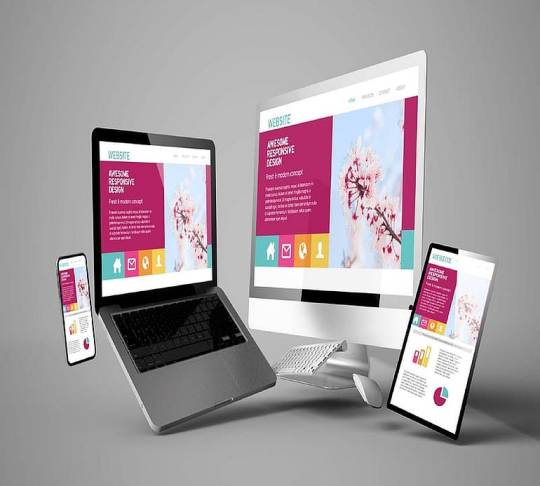
Color plays a crucial role in web design, influencing user experience, brand perception, and even conversion rates. Understanding color theory helps designers create visually appealing and effective websites. This guide explores the principles of color theory and how to choose the right palette for your brand.
Understanding Color Theory
Color theory is the study of how colors interact and the psychological effects they have on viewers. The three main components of color theory include:
Hue: The base color (e.g., red, blue, yellow).
Saturation: The intensity or purity of a color.
Brightness: How light or dark a color appears.
By mastering these elements, designers can create harmonious and aesthetically pleasing color schemes.
The Psychology of Colors
Different colors evoke different emotions and associations. Understanding color psychology helps designers make strategic choices:
Red: Passion, energy, urgency (often used in call-to-action buttons).
Blue: Trust, professionalism, calmness (popular in corporate and tech brands).
Yellow: Optimism, happiness, creativity (often used in playful and youthful brands).
Green: Growth, health, eco-friendliness (common in wellness and sustainability industries).
Purple: Luxury, creativity, wisdom (used in beauty and premium brands).
Black: Elegance, sophistication, power (often used for luxury brands).
White: Simplicity, cleanliness, modernity (common in minimalist designs).
Choosing the Right Color Palette
1. Understand Your Brand Identity
Your brand’s personality and values should guide your color choices. Define what emotions and messages you want to convey through your website’s design.
2. Use the Color Wheel
The color wheel helps designers create visually appealing color combinations:
Complementary Colors: Opposite on the wheel, providing strong contrast (e.g., blue and orange).
Analogous Colors: Next to each other on the wheel, creating harmony (e.g., blue, green, and teal).
Triadic Colors: Evenly spaced on the wheel, offering balanced contrast (e.g., red, yellow, and blue).
Monochromatic Colors: Different shades and tints of the same hue for a cohesive look.
3. Limit the Number of Colors
A balanced website design typically includes:
Primary Color: The dominant color representing the brand.
Secondary Color: A complementary or contrasting color to support the primary.
Accent Color: Used sparingly to highlight key elements (e.g., buttons, links).
4. Consider Accessibility
Ensure your color choices are inclusive and easy to read. Use high contrast for text and background elements and follow Web Content Accessibility Guidelines (WCAG) to improve readability for all users.
5. Test Your Palette
Before finalizing your colors, test them on different devices and in various lighting conditions to ensure consistency and usability.
Tools for Selecting Color Palettes
Several online tools help designers create and test color palettes:
Adobe Color: Generates harmonious color schemes.
Coolors: Allows easy exploration of different palettes.
Material Design Palette: Offers color combinations based on Google’s design principles.
Contrast Checker: Tests readability and accessibility of color choices.
Conclusion
Choosing the right color palette for your website is essential for brand recognition, user engagement, and visual appeal. By understanding color theory, psychology, and practical design principles, designers can craft compelling and effective web experiences. Invest time in selecting a palette that reflects your brand identity while ensuring usability and accessibility for all visitors.
Devoq Design is a premier UI/UX design agency serving businesses in UI/UX Design Agency in Tweed Heads and UI/UX Design Agency in Coffs Harbour, delivering exceptional digital experiences through innovative design solutions. Specializing in user-centric design, Devoq Design creates intuitive, visually appealing, and highly functional interfaces for websites, mobile applications, and enterprise platforms. Their team of experts leverages the latest design trends, usability research, and interactive prototyping to craft seamless digital experiences that enhance engagement and drive business growth. Whether for startups or established businesses in Tweed Heads and Coffs Harbour, Devoq Design ensures top-tier design solutions that elevate brand identity and improve user satisfaction.
0 notes
Text
Why Accessibility is Important in Mobile App Development - Top Mobile App Development Company in India
Understanding Mobile App Accessibility
Mobile app accessibility ensures that digital products are accessible to individuals of all abilities, including those with disabilities. Making accessibility a priority enables companies to serve a larger population and improve user experience. The top mobile app development company in India incorporates accessibility features to develop user-friendly apps.
Major Advantages of Mobile App Accessibility
1. Compliance with Law
Different regulations around the world mandate digital websites and applications to be available for people with disabilities. A mobile app built by the top mobile app development company in India is compliant with standards like the Web Content Accessibility Guidelines (WCAG) and the Americans with Disabilities Act (ADA), minimizing legal liability for companies.
2. Improved User Experience
Available mobile applications have intuitive navigation, legible fonts, voice commands, and dynamic interfaces. All these elements render apps more accessible, providing an improved experience for everybody, including individuals with disabilities.
3. Stronger Brand Reputation
Incorporating accessibility in mobile apps demonstrates corporate social responsibility and inclusivity. Companies that prioritize accessibility establish a positive brand image and foster greater customer loyalty.
4. SEO and App Store Optimization Benefits
Search engines and app stores favor accessible mobile apps due to improved usability and engagement. A well-optimized application developed by an android development company in Noida can achieve higher rankings, driving increased visibility and downloads.
Essential Features for an Accessible Mobile App
To create an inclusive mobile experience, apps should include:
Alternative Text for Images: Providing descriptive text for users who rely on screen readers.
Keyboard Navigation Support: Allowing seamless navigation using external keyboards.
Color Contrast and Text Scaling: Ensuring readability for users with visual impairments.
Subtitles and Transcriptions: Making content accessible to users with hearing disabilities.
Intuitive UI/UX Design: Simplifying navigation for users with cognitive challenges.
Why Choose a Professional App Development Company?
Creating an accessible mobile app requires specialized knowledge. Collaborating with an android development company in Noida ensures that accessibility features are integrated during the development process. Experts implement industry-best practices and cutting-edge technologies to deliver highly accessible applications.
Additionally, businesses looking for web-based accessibility solutions can benefit from the expertise of the best web app development company in Noida. These professionals develop inclusive web applications, providing a consistent experience across platforms.
Conclusion
Accessibility is a crucial element in mobile app design, promoting inclusivity and compliance while enhancing brand reputation. Businesses that invest in accessible app development can expand their reach, improve user satisfaction, and gain a competitive advantage. To create a fully accessible mobile application, partnering with the best mobile app development company in India is essential.
For high-quality, accessible mobile applications, consult Macreel Infosoft Pvt. Ltd. the leading android development company in Noida and the best web app development company in Noida today!
0 notes
Text
AI in Web Design: How Artificial Intelligence is Changing the Game

Introduction
Artificial Intelligence (AI) is revolutionizing various industries, and web design is no exception. AI-powered tools and technologies are transforming the way websites are created, optimized, and personalized. From automating design processes to enhancing user experiences, AI is making web design faster, smarter, and more efficient.
In this article, we’ll explore how AI is changing web design, its benefits, popular AI-driven tools, and what the future holds.
How AI is Transforming Web Design
1️⃣ Automated Website Builders
AI-driven website builders like Wix ADI, Bookmark, and Zyro allow users to create websites without any coding or design experience. These tools analyze user preferences and generate a fully functional, aesthetically pleasing website in minutes.
2️⃣ AI-Generated Design Suggestions
AI analyzes user behavior and industry trends to suggest optimal layouts, fonts, and color schemes. Adobe Sensei and Figma AI use machine learning to provide design recommendations, ensuring a visually appealing and user-friendly experience.
3️⃣ Personalized User Experiences
AI enhances user experience (UX) by dynamically adjusting website content based on user behavior. AI-powered chatbots, recommendation engines, and predictive analytics help deliver a personalized browsing experience.
4️⃣ Automated Content Creation & Optimization
AI copywriting tools like ChatGPT, Copy.ai, and Jasper generate engaging web content.
AI-powered SEO tools (e.g., Surfer SEO, Clearscope) analyze search trends to optimize content for higher rankings.
5️⃣ Smart Chatbots & Virtual Assistants
AI chatbots such as ChatGPT, Drift, and Intercom provide real-time customer support, answer queries, and improve user engagement without human intervention.
6️⃣ AI-Powered UX Testing & Heatmaps
AI analyzes visitor interactions using heatmaps, session recordings, and A/B testing to optimize website performance. Tools like Hotjar, Crazy Egg, and FullStory help designers improve usability.
7️⃣ AI in Web Accessibility
AI-driven accessibility tools like AccessiBe and UserWay automatically adjust web elements to make sites accessible for users with disabilities, ensuring compliance with WCAG guidelines.
Benefits of AI in Web Design
✅ Faster Development: AI automates design and coding, reducing development time. ✅ Cost-Effective: AI-driven solutions lower the cost of hiring designers and developers. ✅ Data-Driven Decisions: AI analyzes user data to optimize designs based on real-world interactions. ✅ Enhanced UX: AI customizes websites in real time for better engagement and conversions. ✅ Improved SEO: AI-driven SEO tools enhance visibility and organic traffic.
Challenges & Considerations
❌ Lack of Human Creativity: AI lacks the intuition and emotional depth of human designers. ❌ Over-Reliance on Automation: Fully automated designs may lack uniqueness. ❌ Ethical Concerns: AI-generated content and recommendations must be monitored for biases.
Future of AI in Web Design
🚀 AI-powered design assistants will become more advanced, creating near-human design quality. 🚀 Voice and AR/VR integration will enhance interactive web experiences. 🚀 AI-driven no-code platforms will empower non-tech users to build complex websites.
Conclusion
AI is reshaping the landscape of web design, making it more accessible, efficient, and data-driven. While it can’t fully replace human creativity, AI is a powerful tool that designers can leverage to enhance their workflows and create better user experiences.
WEBSITE: https://www.ficusoft.in/web-designing-training-in-chennai/
0 notes
Text
Why Web Accessibility Should Be Part of Your Digital Transformation Strategy

The need to transform digitally has evolved past its status as a trendy term because it represents an essential requirement for market competitiveness. When companies update their digital platforms including websites and apps they must evaluate both design aesthetics and user accessibility for all individuals. Web accessibility functions as the essential solution.
What is Web Accessibility?
Web accessibility requires designing digital content and websites to function for users who have different disabilities. The scope of web accessibility reaches users who experience visual impairments along with hearing impairments and motor disabilities and cognitive limitations. Website accessibility enables all users regardless of ability to navigate understand and interact with content.

Why Should Web Accessibility Be a Priority?
Inclusive User Experience for All Your digital platform achieves inclusivity through web accessibility. The worldwide population contains 15% of people who have disabilities. A website designed for accessibility enables a large number of people to connect with your content while accessing your products and services. The result of web accessibility is an inclusive online environment that serves users with all abilities.
Better Search Engine Optimization (SEO) Search engines rank web pages better when they are designed for accessibility. The accessibility principles that enhance website usability also improve search engine content comprehension through techniques such as image alt text and audio transcript provision. Your website's improved search ranking through accessibility measures will drive more traffic together with increased visibility.
Legal Compliance An increasing number of jurisdictions worldwide are passing accessibility requirements for websites. The Americans with Disabilities Act (ADA) in the U.S. forces businesses to give customers equal access to their products and services. Your website must be accessible because failure to do so creates legal exposure. By actively working on web accessibility you can prevent legal problems while maintaining compliance with existing standards.
Improved Brand Reputation Modern consumers demand social responsibility from businesses. Your dedication to web accessibility demonstrates that you support all your customers through a powerful communication signal. When customers see your organization's commitment to accessibility they will trust you more while also attracting additional customers who value inclusivity.
Future-Proofing Your Digital Assets Digital technology development brings better accessibility standards into mainstream best practices. Your digital transformation today should include accessibility to create a future-proof website or platform. The implementation of accessibility standards at present allows organizations to prevent expensive redesign efforts in the future.
Better Usability for Everyone Your accessibility enhancements will create benefits that extend beyond users with disabilities. By implementing clear navigation and readable fonts users with cognitive disabilities benefit alongside users who do not have disabilities. Users can choose between voice search and keyboard navigation to access websites more easily regardless of their capabilities.

How to Integrate Accessibility into Your Digital Transformation Strategy
Audit Your Current Website Begin your accessibility assessment by evaluating your current website's accessibility features. Website accessibility analysis tools such as Google Lighthouse and WAVE help detect accessibility problems including image alt text omissions and difficult color contrast combinations. The initial stage of improvement discovery begins with this assessment process.
Adopt Web Content Accessibility Guidelines (WCAG) The Web Content Accessibility Guidelines (WCAG) function as the international benchmark for designing accessible websites. By following these guidelines your site will satisfy fundamental accessibility criteria that include text alternatives for non-text content alongside keyboard navigation and appropriate text/background contrast levels.
Collaborate with Accessibility Experts Professional web accessibility experts will help you design accessible websites when you lack expertise in this field. Expert professionals will lead you step-by-step from design to development until your site achieves full accessibility.
Test with Real Users After improving your website test it using real users who have disabilities to validate your changes. Users testing the website provide feedback which reveals problems that automated assessment failed to detect. The testing process enables users to achieve a superior integrated experience.
Conclusion
Web accessibility stands as an essential component within your digital transformation strategy. Your digital presence gains stability through accessibility while you create inclusive user experiences and boost your SEO rankings. Your business will secure long-term success while doing right by creating accessibility for all users when you make accessibility a priority. Begin your journey today by making your website accessible and welcome the inclusive future that awaits you.
0 notes
Text
Top Trends to Look for When Selecting the Best Web Design Company in 2025

In the ever-evolving digital landscape, a strong online presence is a necessity for businesses looking to thrive. A well-designed website is the cornerstone of this presence, acting as a business's digital storefront. Choosing the Best Web Design Company in India can be a game-changer in achieving your business goals. But with countless options in the market, how do you decide which company to trust?
As we step into 2025, it’s crucial to understand the trends shaping the web design industry. A forward-thinking web design company will incorporate these trends to create innovative, user-centric websites that stand out in a competitive digital world. Here are the top trends to look for when selecting the Best Web Design Company in India.
1. Focus on User-Centric Design
User experience (UX) is the foundation of any successful website. Modern web design prioritizes creating seamless, intuitive, and engaging user journeys. The best web design companies in India understand the importance of UX and employ strategies like:
Clear navigation.
Responsive layouts.
Optimized loading speeds.
A user-centric website not only improves customer satisfaction but also boosts conversions and reduces bounce rates. Ensure the web design company you choose emphasizes UX in their projects.
2. Mobile-First Design Approach
With mobile devices accounting for the majority of web traffic, a mobile-first design approach is no longer optional—it’s essential. A leading web design company will prioritize creating websites that are fully optimized for smaller screens. Key aspects of the mobile-first design include:
Minimalistic layouts.
Touch-friendly navigation.
Prioritization of essential content.
By adopting a mobile-first strategy, your website will cater to a broader audience and enhance user engagement across all devices.
3. Emphasis on Visual Storytelling
Visual storytelling is a powerful tool in web design, helping businesses connect with their audiences emotionally. In 2025, expect web design companies to focus on creating visually compelling websites using:
High-quality images.
Animations and micro-interactions.
Video backgrounds.
The best web design companies in India will understand how to balance visual elements with functionality to create an immersive user experience.
4. Integration of AI and Chatbots
Artificial intelligence (AI) and chatbots are becoming integral to modern websites. They enhance user interaction, provide real-time support, and gather valuable customer insights. When evaluating the Best Web Design Company in India, ensure they have expertise in integrating AI tools like:
Chatbots for instant customer support.
Personalized content delivery systems.
Predictive search functionalities.
A website with intelligent features can significantly improve user satisfaction and increase engagement.
5. Sustainable and Inclusive Design
Sustainability and inclusivity are not just buzzwords—they are crucial aspects of modern web design. Companies are becoming more aware of the environmental impact of digital technologies, leading to the rise of sustainable web design practices. Look for a web design company that:
Creates energy-efficient websites with optimized coding.
Adheres to web accessibility standards (WCAG).
Designs for inclusivity, ensuring everyone, regardless of ability, can navigate the website seamlessly.
Choosing a company that aligns with these values can also enhance your brand's reputation.
6. Custom CMS Solutions
A good content management system (CMS) is essential for businesses looking to manage their websites easily. The best web design companies in India will offer custom CMS solutions tailored to your needs. Popular options include:
WordPress for flexibility.
Shopify for e-commerce.
Custom-built CMS for unique requirements.
Custom CMS solutions ensure that your website is not only functional but also scalable as your business grows.
7. Search Engine Optimization (SEO) Integration
An aesthetically pleasing website is of little use if it doesn’t rank well on search engines. The Best Web Design Company in India will integrate SEO best practices into the design process. Key aspects to look for include:
Mobile-friendly designs.
Fast loading speeds.
Schema markup for better search visibility.
A design company that prioritizes SEO will help your website achieve higher rankings and drive organic traffic.
8. Focus on Security
Cybersecurity is a top priority for businesses, especially with the rise of cyber threats. The best web design companies will ensure your website is secure by:
Implementing SSL certificates.
Providing regular software updates.
Employing advanced encryption methods.
A secure website not only protects your data but also builds trust with your customers.
9. Integration of AR and VR
Augmented reality (AR) and virtual reality (VR) are making waves in web design, especially for e-commerce, real estate, and education websites. These technologies offer interactive and engaging experiences for users. A forward-thinking web design company will have expertise in incorporating AR and VR into websites to create a cutting-edge digital presence.
10. Strong Portfolio and Client Reviews
Finally, the hallmark of the Best Web Design Company in India is a strong portfolio and positive client testimonials. Reviewing past projects can give you insights into the company’s design approach, creativity, and technical expertise. Additionally, client reviews highlight their reliability and customer service.
Final Thoughts
In 2025, selecting the Best Web Design Company in India requires more than just a glance at their services. It’s about identifying a partner who understands your brand, aligns with your goals, and stays updated with the latest trends. From user-centric designs and mobile-first approaches to AI integration and sustainable practices, the right web design company will create a website that not only looks great but also performs exceptionally well.
Invest in a web design company that embraces innovation and prioritizes your business’s success. After all, your website is more than a digital platform—it’s the heart of your brand’s online identity.
#Best Web Design Company in India#Web Designing Agency India#Web Designers in Cochin#Design and Development Company Kerala#E-Commerce Website Design India#Best UX/UI Design Agency India#UI/UX Designers India#Creative Web Designing Company India#Web Application Development India#digital marketing#branding#advertising agency#India#Kochi#Kerala
0 notes
Text
Accessible Website Design
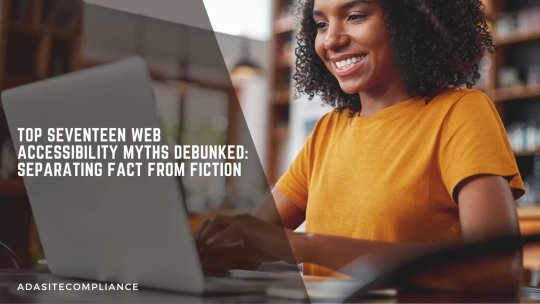
Top Seventeen Web Accessibility Myths Debunked: Separating Fact from Fiction
Accessibility is no longer a ‘luxury’.
Incorporating accessibility into a website today comes part and parcel with web development. With the internet harboring users with and without disabilities who use it for information, bookings, enrollments, purchases, and even jobs, websites need to be compliant.
Unfortunately, many aren’t because some misconceptions and myths cause confusion and hesitance to hinder progress. So here’s an attempt at separating fact from fiction by debunking the top 17 common web accessibility myths.
Remember, web accessibility is no longer just a legal requirement; it’s part of digital inclusivity. It increases your reach and demonstrates your commitment to serving everyone in your community.
If achieving compliance seems overwhelming, we at ADA Site Compliance can simplify things for you. Our team of accessibility experts can help you meet these requirements while you focus on your core business.
Top 17 Web Accessibility Myths Debunked
Let’s now examine these widely misinterpreted web content accessibility principles and guidelines. At the end of the article, you will realize that all those misconceptions you had about web compliance are just myths.
Myth #1- Web Accessibility is Only for Blind People and Users with Visual Impairments
False.
Other people with varied disabilities, such as deafness, limited motor skills, and cognitive limitations, also visit websites for various reasons. An accessible website gives them access to the information they seek, ensuring your website reaches more people.
Myth #2- Web Content Accessibility Guidelines Compliance Ensures Digital Accessibility
False.
Yes, the WCAG provides a framework to enhance digital accessibility. However, compliance alone is not enough for a completely accessible website. Website owners and developers must understand and implement the WCAG principles, as factors like cumbersome user interfaces, poor content, and insufficient testing can lead to incompliant websites.
Myth #3- Accessibility is Only About Making Websites Accessible
False.
Accessibility applies to other digital assets, including mobile applications, PDFs, and other digital documents. Organizations must thus ensure accessibility across all digital platforms for inclusive digital experiences.
Myth #4- Accessibility is Only Relevant for Disabled People
False.
It is not just people with disabilities that benefit from website accessibility. Digital compliance features benefits extend to broader groups, including:
Older adults facing sensory or cognitive challenges as they age
Individuals with temporary disabilities due to injury, illness, or surgery
People experiencing situational limitations, like background noise
Non-native speakers struggling with language barriers hindering understanding and engagement
Myth #5- Accessibility Means Redesigning a Less Visually Appealing Website
False.
Many businesses believe digital accessibility requires a complete website overhaul or poor visual appeal, which is far from the truth. Minor adjustments can significantly create an accessible digital experience without significant redesign efforts.
Myth #6- Digital Accessibility is Only a Concern for Large Corporations
False.
Size is not a criterion for digital accessibility; failure to meet the many digital accessibility laws can lead to legal repercussions and damage a company’s reputation.
Small businesses may face resource constraints, but the numerous tools and online resources can help them understand and ensure web compliance. Embedding accessibility practices from the start ensures web compliance for companies of all sizes.
Myth #7- Accessibility Limits Websites to Text-Only Content
False.
The myth that accessible websites must be plain, text-heavy, and free of multimedia elements stems from earlier text-based web pages. However, modern standards allow visually engaging, multimedia-rich websites that meet diverse accessibility needs.
Strategies like adding alt text for images and captions and transcripts to videos ensure compatibility with assistive technologies. It not only supports users with disabilities but also enhances everyone’s user experience.
Myth #8- All It Takes Is A Quick Technical Fix For an Accessible Website
False.
Web compliance is more than a simple technological adjustment. True accessibility is not just a developer’s responsibility but the joint effort of various teams, including design, testing, and content creation. Relying solely on automated tools or accessibility overlays does not ensure comprehensive accessibility.
Myth #9- Accessibility Can Be Addressed Last-Minute with Simple Fixes
False.
While adding elements like alt text at the last minute may seem convenient, genuine accessibility requires careful planning and integration. Last-minute changes usually require significant counterproductive restructuring, which may harm the user experience, especially for those requiring accessible design.
Besides, including alt text in sites is only one piece of the accessibility puzzle. A truly compliant website involves various other steps, including:
Semantic HTML tags to structure content and enhance readability and interaction.
Keyboard Navigation of the website.
Color Contrast to make text and images readable.
Focus Management highlights elements currently in use for better navigation and clarity.
Using Selective ARIA when necessary to support assistive technologies, as overuse can create confusion.
An accessible design demands proactive attention to these elements throughout development rather than depending on quick fixes at the end.
Myth #10- Accessibility is Expensive and Time-Consuming
False.
Integrating accessibility into an existing website can seem complex, require multiple resources, and be time-consuming. However, prioritizing accessibility from the start can significantly reduce most associated challenges.
In fact, with the right planning and skilled development teams, accessibility can be achieved with minimal additional time and resources as an integral part of the development process.
AI-powered accessibility tools also make digital accessibility more affordable and accessible for all website owners to use and ensure websites are accessible for individuals with disabilities. They help achieve substantial accessibility improvements in just a few hours by automating the detection and correction of many common accessibility issues.
Myth #11- Achieving Web Accessibility Is Overly Complicated
False.
Web accessibility standards can seem complex, but their implementation is not complicated. Multiple tools and resources are available to help developers and website owners ensure digital accessibility.
It is better to start with basic principles, such as providing alternative text for images and ensuring keyboard navigation, and then later delve deeper into more advanced techniques.
Besides, remember that automated accessibility testing alone cannot guarantee complete digital accessibility. Automated tools can help identify issues such as color contrast and structural errors.
However, they cannot fully address complex challenges like unclear language and intricate site designs. Human review by accessibility experts is crucial in ensuring website compliance.
Myth #12- Accessibility is Just a “Nice-to-Have” Feature
False.
Ensuring website compliance is not an option; it is a strategic move with significant potential to impact your business success. An accessible website can do a lot for your business, such as attracting a larger audience, driving higher revenue, enhancing brand reputation, and mitigating legal risks.
Besides, with legal scrutiny, accessibility can no longer be an option. A website owner does not want a lawsuit, considering the financial and reputational risks of overlooking accessibility efforts.
Myth #13- Accessibility is All About Avoiding Legal Trouble
False.
Contrary to popular belief, accessibility is not only about meeting legal requirements to avoid lawsuits. Legal compliance is essential, but its benefits extend far beyond this. For example, implementing accessible design dramatically enhances user experience and boosts your brand’s reputation.
Besides, accessible content opens your entire website or application to a broader audience, ultimately increasing user satisfaction and building loyalty.
Myth #14- Digital Accessibility is Optional
False.
Accessibility is more than an option; it is a requirement in many countries, enforced through laws and regulations. It may not be the top priority for all website owners, but digital compliance is essential for ethical reasons and for creating an inclusive experience for everyone.
Following accessibility standards helps meet legal obligations and ensures your website reaches a broader audience, including individuals with disabilities.
Myth #15- It’s Better To Have Separate Websites for Disabled Users
False.
It was previously thought that having a separate website for users with disabilities ensured accessibility for disabled people. However, this strategy is ineffective and biased, as managing multiple websites is expensive and work-intensive and can lead to content and performance discrepancies.
It is, instead, better to design and develop a website that is inherently accessible to everybody from the beginning.
Myth #16- Accessibility is a One-Time Fix
False.
Many people think digital accessibility is a one-time fix, with nothing else to do once experts ensure compliance. This misconception has led to poorly designed products that users cannot effectively access.
On the contrary, web compliance requires constant commitment and oversight, with continual integration of accessibility features from the initial design through ongoing maintenance. Website owners and developers must regularly review and update the website to meet evolving accessibility standards and user needs.
Myth #17- Only Disabled Individuals Can Test To Ensure Accessibility
No, this is false.
Disabled individuals who frequently rely on assistive technology are effective accessibility testers. However, they are not the only people equipped to evaluate accessibility. All that is needed are the proper training and accessibility testing tools to become adept at identifying and addressing accessibility issues.
Closing thoughts
Dispelling these seventeen myths should inspire a more inclusive web design and development mindset. Remember, accessibility is a legal requirement and moral commitment to making the digital world available to everyone, regardless of individual abilities.
By prioritizing accessibility in our choices, we can create a more equitable, user-friendly online experience for all. It also increases your reach and demonstrates your commitment to serving everyone in your community.
Do not worry if achieving compliance seems overwhelming. We at ADA Site Compliance can simplify things for you. We have a team of accessibility experts who can help you meet these requirements while you focus on your core business!
#Web Accessibility Myths#Digital Accessibility#ADA Compliance#WCAG Compliance#Inclusive Web Design#Accessibility Testing Tools#Assistive Technologies#Accessible Website Design#Web Compliance#Accessibility Guidelines#Accessibility Misconceptions#Keyboard Navigation#Alt Text for Images#Accessibility Overlays#Color Contrast#website accessibility solutions#ADA site compliance#ADASiteCompliance#adasitecompliance.com
0 notes
Text
#Accessibility Maturity Model#Accessibility Services#WCAG#Section 508#Screen Readers#Disabilities#Accessibility Maturity#Accessibility guide#Accessibility Solutions#Accessible Future#Digital Accessibility#Accessibility Technology#Accessibility Conformance#VPAT#Shift-Left Accessibility#Digital Accessibility Compliance#web accessibility Audit#Accessibility Audit#HTML#Assistive Technologies#AEL Data#Accessibility Design
0 notes
Text

Web Accessibility Solutions by MPS Limited
In today’s digital-first world, web accessibility solutions is crucial for inclusivity. MPS Limited offers comprehensive web accessibility solutions to ensure your digital platforms are accessible to all, including individuals with disabilities. From ADA compliance audits and WCAG standards implementation to accessible design and development, our tailored services guarantee your website meets global accessibility standards. By leveraging cutting-edge technology and expert guidance, MPS Limited helps businesses create user-friendly experiences that cater to diverse audiences. Partner with us to build accessible, compliant, and future-proof digital solutions, reflecting your commitment to inclusivity and innovation. Accessibility isn’t optional—make it your priority with MPS Limited.
0 notes
Text
The Role of Technology in Enhancing Accessibility in City Government
In the modern world, technology is transforming every facet of life, from personal interactions to professional operations. City governments, which are responsible for delivering essential services to millions of citizens, are also embracing technological advancements to make their services more accessible, inclusive, and efficient. With a growing population that includes individuals with disabilities, older adults, and those from diverse cultural and linguistic backgrounds, ensuring accessibility in city government operations has never been more critical. Technology is playing a pivotal role in reshaping the way local governments interact with their residents, enabling a more inclusive environment that fosters greater participation, engagement, and service delivery. This is where accessibility service for city offices plays a key role in breaking down barriers and providing equal access to all citizens.
1. Digital Accessibility: The Foundation of Inclusive Government
The foundation of technological advancements in enhancing accessibility lies in digital accessibility. Local governments have been working toward making their websites, applications, and online services accessible to all residents. This includes ensuring that websites comply with the Web Content Accessibility Guidelines (WCAG), which provide standards for creating content that is accessible to people with disabilities. For example, websites can be made compatible with screen readers for the visually impaired, offer text-to-speech options for those with learning disabilities, and allow keyboard-only navigation for individuals with motor impairments.
By offering these accessibility services for city offices in an accessible digital format, local governments enable individuals to access important information and services remotely. This is particularly crucial for people who may face barriers to physically visiting government offices, such as those with mobility challenges, those who work non-traditional hours, or those living in rural areas with limited access to transportation.
2. Smart City Solutions for Enhanced Accessibility
Smart city technology involves the integration of Internet of Things (IoT) devices, data analytics, and sensors to improve the quality of life for citizens. One of the major benefits of smart city technology is the way it helps improve accessibility in urban environments. For example, smart traffic systems can improve the flow of traffic and reduce congestion, which is particularly beneficial for people with disabilities or seniors who rely on public transportation. Real-time updates on public transport accessibility, such as whether a bus has wheelchair access or whether a subway elevator is out of service, provide crucial information to residents, enabling them to plan their routes accordingly.
Additionally, sensor-enabled infrastructure, such as tactile paving for the visually impaired, is being integrated into cities to ensure that public spaces are more navigable for everyone. These sensors can provide data on accessibility in real-time, which helps city officials maintain and improve services proactively, addressing issues before they become widespread problems. These smart city solutions are integral to providing accessibility service for city offices by ensuring that urban environments are both physically and digitally accessible to all residents.
3. Mobile Applications and Online Services for Accessibility
Mobile applications are an essential tool in making city government services more accessible. Many cities have developed apps that allow residents to access a range of government services at their fingertips. These applications are designed to be user-friendly, providing access to everything from paying taxes to reporting local issues such as potholes or broken streetlights.
For individuals with specific needs, mobile apps can be tailored to provide enhanced accessibility features. For example, city apps may offer voice-command capabilities, text-to-speech functions, or high-contrast visual settings to ensure that individuals with varying disabilities can use them effectively. Similarly, online portals for public services can provide information in multiple languages to serve diverse populations, making these services even more inclusive.
With these applications, accessibility services for city offices are extended beyond traditional in-person visits, allowing residents to engage with their local government anytime, anywhere, ensuring that services are available to all.
4. Video Conferencing and Virtual Services
Video conferencing technology has become increasingly vital for promoting accessibility in local government meetings. Whether it is a city council meeting or a community forum, video conferencing allows residents to participate in local governance from the comfort of their homes. This is particularly beneficial for individuals with disabilities, elderly residents, and parents with young children who may otherwise face barriers to attending in-person meetings.
Virtual platforms not only facilitate participation but also ensure that meetings are more inclusive by offering features like real-time captioning, sign language interpretation, and the ability to view content in different formats. This level of accessibility makes it easier for residents to engage with their local government, voice concerns, and contribute to decision-making processes. Video conferencing is an essential accessibility service for city offices, allowing for broader participation and ensuring that local governance is transparent and inclusive.
5. Assistive Technologies in Government Offices
Assistive technologies, such as hearing loops, video relay services (VRS), and augmented reality tools, are being increasingly integrated into city government offices to make them more accessible. For example, hearing loops amplify sound for individuals with hearing aids, ensuring they can fully participate in public meetings or interactions with government employees. VRS allows individuals with hearing impairments to communicate using sign language, breaking down communication barriers in city offices and ensuring that all residents can access necessary services.
Additionally, augmented reality (AR) can be used in public spaces, helping individuals navigate government buildings. AR apps can provide real-time directions or visually enhance signage, making it easier for individuals with visual impairments or those unfamiliar with the layout of a building to find the services they need. These assistive technologies are crucial accessibility services for city offices, providing an inclusive environment where all individuals can interact with government staff and access services on equal terms.
6. Data Analytics for Accessibility Planning
Data analytics plays a crucial role in identifying accessibility gaps and informing decision-making. By collecting and analyzing data from residents, local governments can gain insights into the needs and challenges faced by different communities. For instance, data from accessibility surveys or public service usage patterns can help governments prioritize infrastructure improvements, such as adding ramps to public buildings or improving the accessibility of public transportation systems.
By using data to make informed decisions, city governments can take proactive measures to address accessibility issues and improve service delivery for residents who may otherwise be marginalized. This data-driven approach supports the continuous improvement of accessibility services for city offices, ensuring that government services are responsive to the needs of all residents.
7. The Future of Accessible City Governments
The future of accessible city governments lies in the continuous evolution of technology. As advancements in artificial intelligence (AI), machine learning, and robotics progress, the possibilities for enhancing accessibility in city governance will expand even further. For example, AI-powered chatbots could assist residents with disabilities in navigating government websites or finding services that suit their needs. Similarly, advanced robotics could assist with tasks such as providing assistance to people with mobility impairments or delivering documents to residents with limited mobility.
As cities become more technologically advanced, the focus must remain on ensuring that all residents, regardless of ability, have equal access to services and opportunities. The integration of technology into city government operations is essential for creating a more inclusive and accessible future for urban communities. The continuous improvement of accessibility services for city offices will pave the way for more equitable and efficient government service delivery.
0 notes
Text
The Importance of Responsive Design for Mobile Users

In today’s digital landscape, mobile design usage has surpassed desktop browsing, making responsive design a crucial element for websites and web applications. A responsive design ensures that a website adapts to different screen sizes and provides an optimal user experience, regardless of the device being used. Without responsiveness, a site can become difficult to navigate, leading to poor user engagement and high bounce rates. In this blog, we will deeply explore the significance of responsive design for mobile users and why it is essential for modern web development.
1. Enhancing User Experience (UX)
Problem:
A website that doesn’t adapt well to mobile devices can frustrate users, making navigation difficult and content hard to read.
Solution:
Implement flexible layouts that adjust seamlessly to various screen sizes.
Use fluid grids and scalable images to maintain consistency across devices.
Ensure that touch interactions are smooth and buttons are appropriately sized for mobile users.
Adopt a mobile-first approach, designing with smaller screens in mind before scaling up to larger displays.
2. Improving Mobile Accessibility
Problem:
Websites that are not optimized for mobile use can exclude a significant portion of users, including those with disabilities.
Solution:
Follow Web Content Accessibility Guidelines (WCAG) to ensure inclusivity.
Provide text alternatives for non-text elements, such as images and icons.
Design intuitive navigation with accessible menus and links.
Optimize forms for mobile by using larger input fields and auto-suggestions to facilitate ease of use.
3. Boosting SEO Rankings
Problem:
Google prioritizes mobile-friendly websites in its search results, meaning non-responsive sites risk lower rankings and reduced visibility.
Solution:
Use responsive web design to meet Google’s mobile-first indexing criteria.
Optimize loading speed by compressing images and leveraging caching.
Avoid intrusive interstitials that disrupt the mobile browsing experience.
Implement structured data to enhance search engine understanding and indexing.
4. Increasing Conversion Rates
Problem:
Users are less likely to complete a purchase or sign-up process on a website that is not mobile-friendly.
Solution:
Simplify navigation and streamline the checkout process for mobile users.
Ensure call-to-action (CTA) buttons are prominent and easy to click.
Minimize form fields and allow autofill features for quick data entry.
Provide multiple payment options optimized for mobile transactions.
5. Reducing Bounce Rates
Problem:
A poor mobile experience leads to users leaving a site quickly, which negatively impacts engagement metrics.
Solution:
Improve page load speeds through performance optimizations.
Make content scannable with readable fonts and appropriate spacing.
Implement engaging visuals that do not compromise loading times.
Enhance interactivity with mobile-friendly animations and microinteractions.
6. Future-Proofing Your Website
Problem:
With the growing variety of devices, from smartphones to tablets and foldable screens, websites must be adaptable.
Solution:
Use CSS media queries to ensure design flexibility across multiple device types.
Test websites on different screen sizes and resolutions.
Continuously update and refine designs based on evolving mobile trends.
Leverage progressive web applications (PWAs) to provide an app-like experience.
7. Meeting User Expectations
Problem:
Modern users expect seamless and fast experiences when browsing on mobile.
Solution:
Maintain design consistency to create familiarity across different devices.
Ensure that interactive elements, such as menus and carousels, function properly on mobile.
Enable offline browsing capabilities through caching and service workers.
Optimize content placement to align with common mobile user behaviors.
Conclusion
Responsive design is no longer optional—it is essential for delivering a positive user experience, improving accessibility, and achieving business goals. As mobile users continue to grow, ensuring that your website is responsive will help you stay competitive, retain visitors, and boost conversions. By adopting best practices in responsive web design, you create a seamless experience that benefits both users and search engines, ultimately leading to a successful and future-proof online presence.
0 notes
Text
10 Best AI Accessibility Tools for Websites (January 2025)
New Post has been published on https://thedigitalinsider.com/10-best-ai-accessibility-tools-for-websites-january-2025/
10 Best AI Accessibility Tools for Websites (January 2025)
Web accessibility has become essential for businesses as digital inclusion moves from optional to mandatory. With over 1 billion people worldwide living with disabilities and increasing legal requirements around digital accessibility, organizations need effective tools to make their online presence accessible to everyone.
Here are some of the top leading AI-powered accessibility solutions that help businesses create inclusive digital experiences while maintaining compliance with accessibility standards.
UserWay brings AI-powered accessibility to websites through an intelligent widget that automatically enhances the online experience for users with disabilities. This smart solution transforms website code in real-time, ensuring compliance with major accessibility standards like WCAG 2.1 & 2.2 and ADA.
The system’s intelligence comes through its automatic detection and correction capabilities. It scans website code and makes precise adjustments without requiring technical expertise from site owners. Each visitor can access tailored accessibility profiles designed for specific needs – from motor impairments to visual challenges to cognitive differences. The widget acts as an intelligent interpreter, translating website content into formats that work for each user’s unique requirements.
Major brands like Payoneer, Fujitsu, and Kodak have seen concrete results from implementing UserWay. A case study by Natural Intelligence showed notable improvements in key metrics – higher click-through rates, lower bounce rates, and better conversion numbers. Beyond performance gains, UserWay also offers peace of mind through a $10,000 monetary pledge for annual Pro Widget customers, supporting them against potential accessibility challenges.
Key features:
Automated code analysis and correction system that maintains WCAG and ADA compliance
Specialized accessibility profiles addressing different disability types and user needs
Multi-language support framework serving over 50 languages worldwide
Privacy-focused architecture with ISO 27001 certification
Built-in legal protection system including documentation and support
Visit UserWay →
accessiBe brings together AI, machine learning, and computer vision to make websites naturally accessible to everyone. Their system works continuously in the background, intelligently adapting web content to meet diverse accessibility needs while keeping websites compliant with WCAG 2.1 and ADA standards.
The platform operates through two interconnected systems. The accessibility interface acts as a smart control center, giving users precise control over their browsing experience – from adjusting fonts and colors to optimizing navigation patterns. Meanwhile, the AI engine works invisibly, analyzing webpage elements to understand their purpose and function. This dual approach creates a seamless experience where websites naturally adapt to each user’s needs, whether they are using screen readers, keyboard navigation, or other assistive technologies.
With over 100,000 websites worldwide putting their trust in accessiBe, the platform has become a cornerstone of digital inclusion. The system’s development involved direct collaboration with users who have disabilities, ensuring it addresses real-world challenges effectively. For businesses, this translates to expanded reach and reduced legal risk, all through a solution that works continuously to maintain accessibility as websites evolve.
Key features:
AI-powered contextual analysis system for automatic content adaptation
Image recognition engine providing detailed alternative text descriptions
Daily monitoring framework ensuring continuous compliance
Customizable interface supporting various disability profiles
Built-in litigation support package with comprehensive documentation
Visit accessiBe →
Stark offers teams a unified platform that brings inclusivity into every stage of product development. This intelligent suite works seamlessly across popular design and development environments like Figma, Sketch, and GitHub.
The platform takes a proactive approach to accessibility. Rather than waiting until the end of development to address issues, Stark’s AI-powered system catches potential barriers as early as the first design draft. This early detection proves transformative – teams using Stark report fixing accessibility issues up to 10 times faster than with traditional methods, while reducing 56% of issues that typically slip into code where fixes become significantly more costly.
The world’s leading companies, from ambitious startups to Fortune 100 enterprises, have made Stark their foundation for digital accessibility compliance. The system’s GDPR and SOC2-certified platform provides real-time insights and continuous monitoring across design files, code repositories, and live products. For teams of all sizes, this means having a central hub where designers, developers, and product managers can collaborate effectively on creating inclusive digital experiences.
Key features:
Integrated accessibility testing system working across major design and development tools
AI-powered suggestion engine for rapid issue detection and resolution
Real-time monitoring framework providing continuous compliance insights
Role-specific toolsets supporting different team members’ needs
Enterprise-grade security architecture with zero-trust policy
Visit Stark →
AudioEye brings a mix of intelligent automation and human expertise to web accessibility, creating digital spaces where every visitor can fully engage with content. This platform goes beyond simple fixes, combining AI-driven solutions with insights from certified experts and members of the disability community.
The system operates through a three-layered approach to digital inclusion. First, active monitoring continuously scans web pages as visitors interact with them, gathering real-time insights about accessibility challenges. Then, a powerful automation engine instantly addresses common barriers, while certified experts craft custom solutions for more nuanced issues. This dual approach creates a dynamic shield against accessibility gaps, with the platform’s proven ability to reduce valid legal claims by 67% compared to other solutions.
Over 126,000 leading brands have chosen AudioEye as their path to digital inclusion. The platform’s comprehensive toolkit – from developer testing resources to custom legal responses – makes it the top-rated solution for ease of setup according to G2’s 2024 rankings. For businesses aiming to welcome all visitors, including the one in six people globally living with disabilities, AudioEye transforms accessibility from a technical requirement into a seamless part of the digital experience.
Key features:
Real-time monitoring system that adapts to user interactions
Hybrid automation engine combining AI fixes with expert solutions
Custom code development framework for complex accessibility challenges
Comprehensive legal support package with custom response services
Developer toolkit enabling proactive accessibility testing
Visit AudioEye →
Allyable takes digital accessibility beyond checkbox compliance by offering enterprises an AI-powered system. Their integrated platform combines automation with personalized expert guidance, creating digital spaces where technology and human insight work together.
The platform uses a modular ecosystem of solutions. The Ally360™ hub serves as a central command center, with real-time accessibility insights. But what sets Allyable apart is their approach to guiding teams through a thoughtful transition, starting with hands-on management and gradually building client teams’ expertise through A11yAcademy™ training and ongoing support.
With over 1.2 billion people worldwide living with disabilities, Allyable’s impact extends beyond technical compliance. Their system integrates seamlessly into existing workflows through a single line of code, connecting with popular tools like Jira and GitHub. For enterprises looking to improve digital inclusion while protecting against rising compliance challenges, Allyable’s mix of AI and human expertise creates a pathway to lasting accessibility.
Key features:
All-in-one accessibility hub providing real-time monitoring
Expert-guided transition system building team independence
Specialized training academy developing internal accessibility expertise
Single-line integration framework connecting with major development tools
Comprehensive security architecture protecting sensitive data
Visit Allyable →
Read Easy.ai transforms complex content into clear, digestible information for individuals with reading challenges. The system converts intricate language patterns into more approachable forms while preserving the essential meaning.
The platform offers versatile deployment across digital spaces. Through a Chrome extension, it functions as an invisible reading companion, instantly adapting website text on demand. For content creators, it embeds seamlessly into Microsoft Office as a thoughtful guide, offering real-time insights about readability and suggesting ways to make text more inclusive. Meanwhile, developers can tap into these capabilities through an API to implement it directly into their applications.
The numbers tell a compelling story about Read Easy.ai’s potential impact. In the US alone, 54% of adults read below a sixth-grade level, while across Europe, 20-25% of the population faces functional literacy challenges. By supporting multiple languages including English, Spanish, German, Dutch, and Portuguese, Read Easy.ai opens digital doors for millions who might otherwise struggle with online content, turning complex text into clear communication.
Key features:
AI-powered text analysis engine that maintains meaning while reducing complexity
Multi-platform integration system working across browsers and applications
Real-time feedback framework for content creators
Developer toolkit enabling custom accessibility solutions
Multi-language support system serving diverse global audiences
Visit Read Easy.ai →
Siteimprove offers organizations tools to proactively find and fix accessibility issues. The platform combines accessibility checking with AI-powered recommendations to improve website accessibility.
The platform includes an automated tool that checks web pages and PDF documents against WCAG 2.2 standards. For teams focused on digital accessibility, Siteimprove provides insights about accessibility issues and guidance for improvements. Their Frontier platform offers training resources to build accessibility knowledge across organizations.
Through built-in dashboards and reporting tools, organizations can monitor their accessibility efforts. The platform supplements automated checks with AI suggestions, helping teams address identified issues.
Key features:
Web page and PDF accessibility checking tools
AI-powered recommendations
Accessibility progress tracking tools
Educational resources for teams
Organization-wide training platform
Visit Siteimprove →
Evinced uses AI and machine learning to find website accessibility problems through visual analysis rather than just code review. This visual approach helps catch issues that traditional accessibility tools miss, including problems typically found only through manual testing.
The system works differently from standard accessibility scanners. When examining a website, it processes screens like a sighted person would, then groups related accessibility issues together. This means instead of producing hundreds of individual bug reports, Evinced identifies common patterns that developers can fix systematically. The platform integrates with existing development tools including Selenium and Cypress for web testing, plus XCUITest and Espresso for mobile apps.
Major development teams rely on Evinced’s suite of tools to catch accessibility issues early in their process. The platform tracks each problem from discovery through resolution, preventing duplicate reports while measuring fix times. This systematic approach helps teams identify and resolve accessibility barriers more efficiently than traditional testing methods.
Key features:
Visual AI analysis that finds issues beyond code scanning
Smart clustering system for related accessibility problems
Issue tracking framework across development cycles
Integration tools for major testing platforms
Complete toolkit spanning design through deployment
Visit Evinced →
RAMP offers web teams a systematic approach to finding and fixing accessibility issues across websites. The platform focuses on achieving compliance with ADA and WCAG standards through automated scanning and guided remediation.
The system works through a four-part process: discovery, understanding, fixing, and compliance monitoring. RAMP’s automated scanner identifies WCAG violations site-wide, while their browser extension shows issues directly on the page. For each problem found, RAMP provides detailed instructions, code snippets, and a task management system that integrates with Jira. Their A11y Center helps organizations track progress and manage accessibility statements.
Key features:
Site-wide scanning system for WCAG violations
Browser extension showing real-time accessibility issues
Task management system with expert remediation guides
Jira integration for streamlined workflow
Compliance tracking center with accessibility statement tools
Visit RAMP →
Equally AI offers an AI engine that works continuously to identify and resolve accessibility barriers while maintaining human oversight for accuracy.
The system’s core strength lies in its 24-hour monitoring cycle. Every day, it scans websites for new content and potential accessibility issues, automatically addressing concerns across WCAG, ADA, and EAA standards. For users, this means having access to customizable accessibility profiles that address specific needs – from vision impairments to cognitive disabilities, ADHD to dyslexia. Website owners can seamlessly integrate these features through popular platforms like WordPress, Wix, Shopify, and Webflow.
Major companies rely on Equally AI to streamline their accessibility efforts. By tackling over 50 common accessibility barriers, Equally AI helps organizations build websites that welcome all users while protecting against compliance risks.
Key features:
AI-powered accessibility correction system
Daily content monitoring and issue detection
Customizable profiles for different accessibility needs
Multi-platform integration framework
Automated compliance documentation tools
Visit Equally AI →
Building a More Accessible Digital Future
Recent data reveals a significant gap in digital accessibility: 89% of users with disabilities still face daily barriers online, despite the growing sophistication of AI-powered solutions. This disconnect between available tools and user experience highlights an essential truth – while AI offers powerful automation and monitoring capabilities, technology alone cannot bridge the accessibility divide.
The business implications are compelling and immediate. With 62% of users ready to switch to more accessible competitors and 51% actively seeking accessible alternatives, organizations can no longer treat accessibility as optional. These AI tools represent different approaches to solving the accessibility challenge – from automated remediation and real-time monitoring to development integration and compliance tracking. Yet their effectiveness ultimately depends on meaningful implementation and ongoing commitment.
As we move through 2025, organizations must shift from viewing accessibility as a compliance checkbox to recognizing it as a fundamental aspect of user experience and business success. Companies that combine these AI capabilities with genuine dedication to inclusion will not just meet legal requirements – they will gain a significant competitive advantage.
#000#2024#2025#accessiBe#Accessibility#ai#ai tools#AI-powered#amp#Analysis#API#applications#approach#apps#architecture#automation#background#Best Of#billion#brands#bridge#browser#browser extension#bug#Building#Business#Case Study#challenge#chrome#code
1 note
·
View note
Text
Convert. Publish. Succeed with EPUB Services

In today’s world, where the internet has become so predominant, making content available to the broadest number of people is more important than ever before. Regardless of whether you are an author, a publisher, or the owner of any type of business with your growing collection of digital resources, EPUB conversions are the key to a number of promising opportunities that eBooks and digital publishing offer in various parts of the world.
Why EPUB?

The eBook format used most around the world is the EPUB, short for Electronic Publication. Versatile, accessible, and reader-independent—user-friendly with every major e-reading platform, including Kindle, Apple Books, Google Play Books, and many more—EPUBs are dynamic and reflowable; in other words, the content accommodates its space by resizing according to any width of screen size, from smartphone up to tablet and desktop monitors, making it easier for your readers to enjoy your book.
The Power of EPUB Conversion
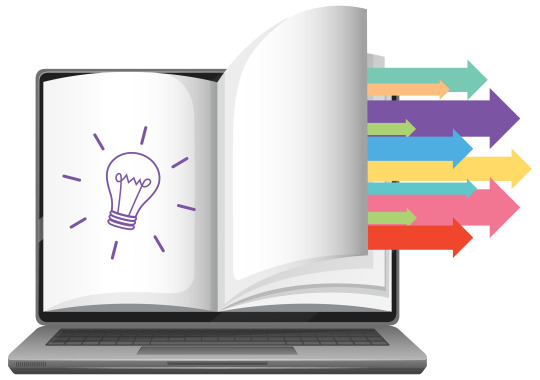
Converting your content into EPUB format offers several advantages:
Increased Accessibility
EPUBs are designed for everyone; your content should be open to those with visual impairment or any other type of disability. Additional features such as advanced typography, TTS compatibility, and responsive web design make it easier to use.
Global Access
EPUB makes certain that your eBooks will be compatible with as many eReaders and commercial platforms as possible. This means your content is useful for an audience anywhere in the world.
Professional Presentation
EPUB conversion makes your content professional and refined with live links, pictures, and videos instead of just plain hyperlinks.
Future-Proof Content
Since eBooks travel with EPUB as the standard format, your content stays future-proof when transitioning into other platforms in electronic publishing.
Our EPUB Conversion Services
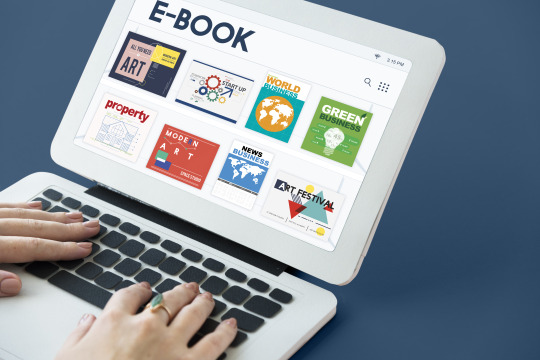
We specialise in converting different types of content—manuscripts, journals, magazines, training materials, and much more—into high-quality EPUB files. Here's what sets our services apart:
Accurate Conversion: We ensure that your original content remains intact, layouts, images, and formatting are maintained as they are.
Customisation: Do you have specific design elements or interactive features? We will tailor the EPUB format to meet your requirements.
All conversions comply with the standards of the world, be it WCAG or that of the marketplaces, Amazon Kindle and Apple Books.
Fast Delivery: We respect time in publishing; therefore, delivery will be quick, without quality being compromised.
How It Works

Submit Your Content: Share your manuscript or document in any format: Word, PDF, or InDesign.
Review and Customise: Share your requirements for design, interactivity, or accessibility.
Conversion and QA: Our specialists convert your content to EPUB and run quality assurance checks to achieve perfection.
Delivery: Get back your market-ready EPUB file to publish on the platform of your choice.
Convert, Publish, and Succeed
This journey starts with the simple step of professional EPUB conversion. Save your time and trouble with our experience, avoiding any technical hiccups in your pursuit of reaching out to a much wider audience.
Whether you're a budding author or an established publisher, we'll handle all the intricacies of EPUB conversion so that you can do your best at making incredible content.
Ready to Get Started?

Upgrade your content stated and level it up. Epublishig BUZZ: your one-stop solution for all your needs! Contact us today for more information on our EPUB conversion services and how we can help you foray into the world of epublishing.
0 notes